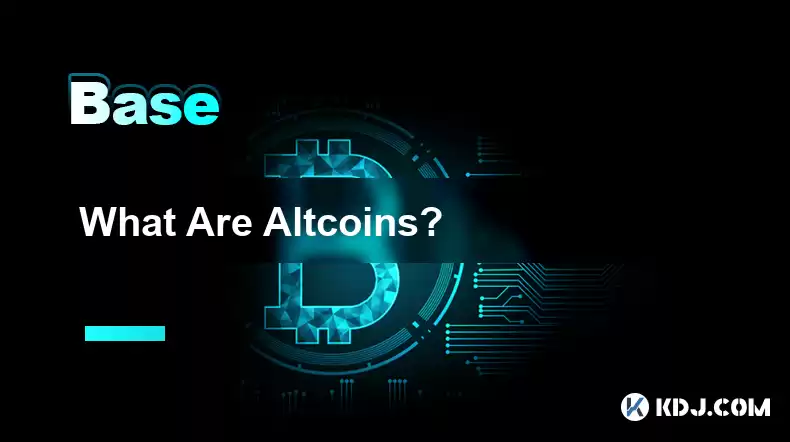-
 Bitcoin
Bitcoin $115000
0.12% -
 Ethereum
Ethereum $3701
4.50% -
 XRP
XRP $3.081
2.99% -
 Tether USDt
Tether USDt $0.0000
-0.01% -
 BNB
BNB $767.9
1.45% -
 Solana
Solana $169.5
3.13% -
 USDC
USDC $0.9999
0.01% -
 Dogecoin
Dogecoin $0.2106
4.30% -
 TRON
TRON $0.3334
1.62% -
 Cardano
Cardano $0.7564
2.54% -
 Stellar
Stellar $0.4165
0.76% -
 Hyperliquid
Hyperliquid $38.75
0.25% -
 Sui
Sui $3.593
3.00% -
 Chainlink
Chainlink $17.08
3.59% -
 Bitcoin Cash
Bitcoin Cash $573.6
4.35% -
 Hedera
Hedera $0.2508
-0.84% -
 Avalanche
Avalanche $23.07
6.46% -
 Ethena USDe
Ethena USDe $1.001
-0.02% -
 Litecoin
Litecoin $120.8
8.17% -
 UNUS SED LEO
UNUS SED LEO $8.943
-0.32% -
 Toncoin
Toncoin $3.400
-5.60% -
 Shiba Inu
Shiba Inu $0.00001255
1.54% -
 Uniswap
Uniswap $9.908
6.32% -
 Polkadot
Polkadot $3.718
2.10% -
 Monero
Monero $303.0
-0.74% -
 Dai
Dai $0.9999
-0.02% -
 Bitget Token
Bitget Token $4.392
0.91% -
 Cronos
Cronos $0.1403
6.31% -
 Pepe
Pepe $0.00001076
1.13% -
 Aave
Aave $267.2
1.80%
What Are Altcoins?
Spanning payment systems to NFTs and the metaverse, altcoins offer a diverse array of use cases, contributing to the burgeoning blockchain landscape.
Dec 14, 2024 at 04:43 am

Understanding the Realm of Altcoins: A Comprehensive Guide
Introduction
Beyond Bitcoin, the blockchain ecosystem is brimming with a myriad of alternative cryptocurrencies, commonly referred to as altcoins. These digital assets offer unique features, varying levels of adoption, and diverse potential use cases. This comprehensive guide delves into the world of altcoins, exploring their nature, evolution, and the factors shaping their market performance.
Unveiling the Distinct Characteristics of Altcoins
Altcoins, characterized by their deviation from Bitcoin, encompass a vast spectrum of cryptocurrencies with distinct attributes and innovative applications. These digital assets diverge from Bitcoin in various ways, including:
- Consensus Mechanisms: Altcoins employ diverse consensus mechanisms, such as Proof-of-Work, Proof-of-Stake, and Proof-of-Burn, offering variations in security, scalability, and energy consumption.
- Governance Models: Altcoins differ in their governance structures, ranging from centralized control to decentralized autonomous organizations (DAOs), giving rise to distinct community involvement and decision-making processes.
- Use Cases: Altcoins cater to a wide array of use cases, spanning payment systems, decentralized finance (DeFi), non-fungible tokens (NFTs), gaming, and supply chain management.
Tracing the Evolution of Altcoins: A Historical Perspective
Altcoins have witnessed a remarkable evolution since their inception, traversing significant milestones and contributing to the burgeoning blockchain landscape:
- Early Altcoins (2011-2013): The emergence of Namecoin, Litecoin, and Peercoin marked the dawn of altcoins, laying the groundwork for the diversification of the cryptocurrency ecosystem.
- Altcoin Boom (2017-2018): A surge in altcoin market capitalization and the rise of Ethereum, fueled by ICOs, propelled the altcoin sector into the mainstream consciousness.
- DeFi Summer (2020): The exponential growth of DeFi protocols and decentralized applications sparked a wave of innovation, driving the adoption of altcoins tailored to DeFi use cases.
- NFTs and Metaverse Surge (2021-Present): The proliferation of NFTs and the advent of the metaverse have fueled a new wave of altcoins, providing the infrastructure for digital ownership and immersive experiences.
Navigating the Market Landscape: Understanding Market Performance
The performance of altcoins is governed by a complex interplay of factors, influencing their value and market dynamics:
- Fundamental Factors: The underlying technology, team behind the project, use cases, and adoption rates play a significant role in determining altcoin value.
- Economic Factors: Market conditions, macroeconomic trends, and interest rates can impact altcoin demand and supply.
- Regulatory Frameworks: Evolving regulatory landscapes can affect altcoin valuations, as governments seek to balance innovation with investor protection.
- Sentiment and Speculation: Market sentiment, investor expectations, and speculative behavior can drive short-term price fluctuations in the altcoin market.
Addressing Common Misconceptions: Dispelling Altcoin Myths
Several misconceptions surround altcoins, clouding their understanding and hindering adoption:
- Altcoins are inferior to Bitcoin: While altcoins differ in characteristics and use cases, they offer their own advantages and contribute to the diversification of the blockchain ecosystem.
- Altcoins are too risky: The risk associated with altcoins varies depending on factors such as underlying technology, adoption, and market conditions. Investors should conduct thorough research and understand the risks involved before investing in any cryptocurrency.
- Altcoins are only used for speculation: While some altcoins may be subject to speculative trading, others serve practical purposes in areas such as DeFi, NFTs, and supply chain management.
- All altcoins are the same: Altcoins encompass a diverse range of projects, each with its unique features, use cases, and target market.
Conclusion
The world of altcoins remains an ever-evolving landscape, offering a plethora of opportunities and challenges for investors and entrepreneurs. By comprehending the diverse nature, evolution, and market dynamics of altcoins, individuals can make informed decisions and navigate the complex crypto ecosystem with greater confidence.
Disclaimer:info@kdj.com
The information provided is not trading advice. kdj.com does not assume any responsibility for any investments made based on the information provided in this article. Cryptocurrencies are highly volatile and it is highly recommended that you invest with caution after thorough research!
If you believe that the content used on this website infringes your copyright, please contact us immediately (info@kdj.com) and we will delete it promptly.
- Velo Universe, DEX, and DeFi Security: Navigating the Future of Decentralized Trading
- 2025-08-05 09:25:13
- Bitget Wallet Revolutionizes Solana with Gas-Free Transactions: A New Era for DeFi
- 2025-08-05 09:25:13
- Ozak AI, Crypto Boom, and ROI Potential: Is This the Next Big Thing?
- 2025-08-05 09:25:24
- Solana's ETF Hopes & the All-Time High Chase: Is SOL Set to Soar?
- 2025-08-05 09:25:24
- Coinbase's Brian Armstrong and the Art of Focused Work: A Deep Dive
- 2025-08-05 09:25:30
- Uniswap Price Prediction: Bullish Reversal on the Horizon?
- 2025-08-05 09:25:30
Related knowledge

What is the difference between CeFi and DeFi?
Jul 22,2025 at 12:28am
Understanding CeFi and DeFiIn the world of cryptocurrency, CeFi (Centralized Finance) and DeFi (Decentralized Finance) represent two distinct financia...

How to qualify for potential crypto airdrops?
Jul 23,2025 at 06:49am
Understanding What Crypto Airdrops AreCrypto airdrops refer to the distribution of free tokens or coins to a large number of wallet addresses, often u...

What is a crypto "airdrop farmer"?
Jul 24,2025 at 10:22pm
Understanding the Role of a Crypto 'Airdrop Farmer'A crypto 'airdrop farmer' refers to an individual who actively participates in cryptocurrency airdr...

What is the difference between a sidechain and a Layer 2?
Jul 20,2025 at 11:35pm
Understanding the Concept of SidechainsA sidechain is a separate blockchain that runs parallel to the main blockchain, typically the mainnet of a cryp...

What is the Inter-Blockchain Communication Protocol (IBC)?
Jul 19,2025 at 10:43am
Understanding the Inter-Blockchain Communication Protocol (IBC)The Inter-Blockchain Communication Protocol (IBC) is a cross-chain communication protoc...

How does sharding improve scalability?
Jul 20,2025 at 01:21am
Understanding Sharding in BlockchainSharding is a database partitioning technique that is increasingly being adopted in blockchain technology to enhan...

What is the difference between CeFi and DeFi?
Jul 22,2025 at 12:28am
Understanding CeFi and DeFiIn the world of cryptocurrency, CeFi (Centralized Finance) and DeFi (Decentralized Finance) represent two distinct financia...

How to qualify for potential crypto airdrops?
Jul 23,2025 at 06:49am
Understanding What Crypto Airdrops AreCrypto airdrops refer to the distribution of free tokens or coins to a large number of wallet addresses, often u...

What is a crypto "airdrop farmer"?
Jul 24,2025 at 10:22pm
Understanding the Role of a Crypto 'Airdrop Farmer'A crypto 'airdrop farmer' refers to an individual who actively participates in cryptocurrency airdr...

What is the difference between a sidechain and a Layer 2?
Jul 20,2025 at 11:35pm
Understanding the Concept of SidechainsA sidechain is a separate blockchain that runs parallel to the main blockchain, typically the mainnet of a cryp...

What is the Inter-Blockchain Communication Protocol (IBC)?
Jul 19,2025 at 10:43am
Understanding the Inter-Blockchain Communication Protocol (IBC)The Inter-Blockchain Communication Protocol (IBC) is a cross-chain communication protoc...

How does sharding improve scalability?
Jul 20,2025 at 01:21am
Understanding Sharding in BlockchainSharding is a database partitioning technique that is increasingly being adopted in blockchain technology to enhan...
See all articles

























































































